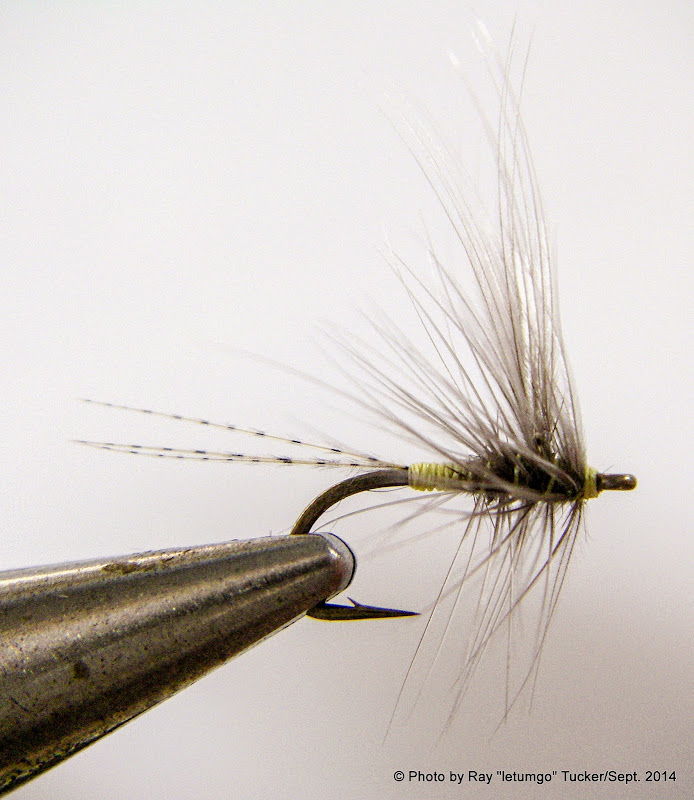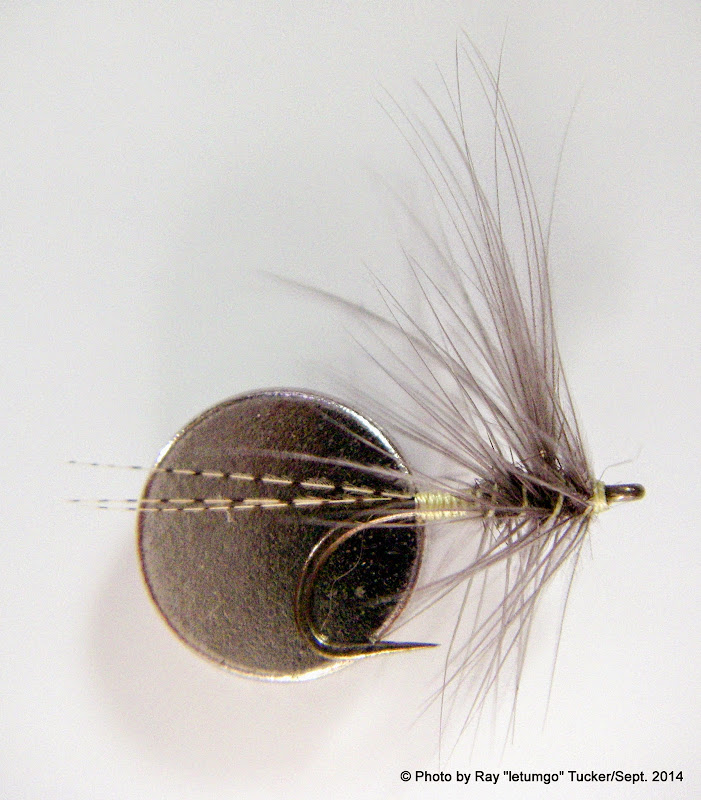Page 1 of 3
Derbyshire Blue Dun (first attempt)
Posted: Sun Sep 21, 2014 4:20 pm
by letumgo

 Derbyshire Blue Dun
Derbyshire Blue Dun
Hook - Gamakatsu Traditional Series (Model S12S-1F Straight Eye Hook / Size 18)
Thread - Pearsall's Gossamer Silk (Waxed Primrose)
Hackle - Whiting Hen Neck Hackle (Medium Dun)
Wing - Bundle of fibers from webby fibers from same hen neck (Medium Dun)
Tail - Three Fibers of Wood Duck Flank (Natural)
Thorax - Mole Fur (Natural/Dun)
This is my first attempt at my swap fly. I have chosen the Derbyshire style and am trying to work out the proportions on a very small hook (size 18). I would appreciate any feedback regarding the Derbyshire style, and any clues to what is likely to be incorrect about my fly.
Overall, this looks like a very fishy little fly. The hackle and webby wing bundle is very soft. It appears the fly would fish well. I imagine this pattern would fish very close to the surface film, looking like a crippled insect.
Anyway, I'd like to hear what changes are needed to be more accurate with the Derbyshire style.
Re: Derbyshire Blue Dun (first attempt)
Posted: Sun Sep 21, 2014 8:03 pm
by Smuggler
Amazing Ray, well done.
Such a fishy pattern, the whispy looking wings really appeal to me.
Re: Derbyshire Blue Dun (first attempt)
Posted: Sun Sep 21, 2014 11:50 pm
by Old Hat
Very pretty fly Ray. Beautiful dainty work. Hard to comment when I have no real knowledge of the Derbyshire style. I like the fly, maybe a bit heavily hackled for me but again could be the style.
Curious why you tried to tie it on an 18. Most of the patterns I came across for the large dark olive were #14 with a very few #16.
Re: Derbyshire Blue Dun (first attempt)
Posted: Mon Sep 22, 2014 1:34 am
by Donald Nicolson
Hi Ray,
In Woolley's book, he has quite a fair sized section on - The Early Olive Dun (Blue Dun) page 98.
He was a Derbyshire man, born and bred, and a brilliant fly-dresser.
I would recommend this article. It was written in 1932, and size 18 hooks were
probably not available.
Re: Derbyshire Blue Dun (first attempt)
Posted: Mon Sep 22, 2014 1:47 am
by Mataura mayfly
I have a few references here that call for a hook of "00" size on the old scale- is that not 17-18 on the new scale?
I do not have the knowledge to comment, but...... I find it hard to distinguish the wing from the hackle. Might just be the way I see it in the photo and they look much different in the hand.

Re: Derbyshire Blue Dun (first attempt)
Posted: Mon Sep 22, 2014 6:57 am
by tie2fish
I have no clue as to what the Derbyshire style should look like, but this fly is a thing of true beauty to my eye. Dainty and "buggy", with perfect proportions and impeccably tied.
Re: Derbyshire Blue Dun (first attempt)
Posted: Mon Sep 22, 2014 7:05 pm
by swellcat
Do you recall how many turns you took for the head? It is certainly compact for what I think of as fat thread.
Is the finish knot at the head or somewhere in the thorax?
Re: Derbyshire Blue Dun (first attempt)
Posted: Mon Sep 22, 2014 7:23 pm
by letumgo
Swellcat - The head is a three-turn whip finish, with waxed thread. one of the wraps is hidden under the other two wraps. The wraps you see in the thorax area are counter wrapped thru the hackle, which was wound backwards towards the hook bend. I wanted the crossing wraps to reinforce the hackle, to make the fly more durable.
Thanks everyone for the feedback. Hank sent me copies of the reference Donald mentioned above. I am studying the reference and will try again, later this week.
I love this sort of group interaction. Very helpful guys.
Re: Derbyshire Blue Dun (first attempt)
Posted: Mon Sep 22, 2014 10:59 pm
by zen leecher
I think the "the Large Dark Spring Olive or Blue Dun" is a larger fly, either a #12 or #14. Now having said that and also seeing your fly, I would not throw your fly out of the fly box. It is a very nicely tied fly and a testament to your tying ability.
Re: Derbyshire Blue Dun (first attempt)
Posted: Tue Sep 23, 2014 9:19 am
by hankaye
zen leecher, Howdy;
zen leecher wrote:I think the "the Large Dark Spring Olive or Blue Dun" is a larger fly, either a #12 or #14. Now having said that and also seeing your fly, I would not throw your fly out of the fly box. It is a very nicely tied fly and a testament to your tying ability.
I can send you the same scans that I sent Ray if you'd like. Just send me a PM.
hank